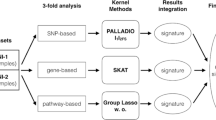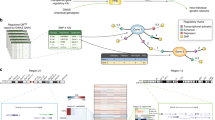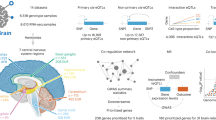Abstract
Genome-wide association studies (GWASs) perform per-SNP association tests to identify variants involved in disease or trait susceptibility. However, such an approach is not powerful enough to unravel genes that are not individually contributing to the disease/trait, but that may have a role in interaction with other genes as a group. Pathway analysis is an alternative way to highlight such group of genes. Using SNP association P-values from eight multiple sclerosis (MS) GWAS data sets, we performed a candidate pathway analysis for MS susceptibility by considering genes interacting in the cell adhesion molecule (CAMs) biological pathway using Cytoscape software. This network is a strong candidate, as it is involved in the crossing of the blood–brain barrier by the T cells, an early event in MS pathophysiology, and is used as an efficient therapeutic target. We drew up a list of 76 genes belonging to the CAM network. We highlighted 64 networks enriched with CAM genes with low P-values. Filtering by a percentage of CAM genes up to 50% and rejecting enriched signals mainly driven by transcription factors, we highlighted five networks associated with MS susceptibility. One of them, constituted of ITGAL, ICAM1 and ICAM3 genes, could be of interest to develop novel therapeutic targets.
This is a preview of subscription content, access via your institution
Access options
Subscribe to this journal
Receive 6 digital issues and online access to articles
$119.00 per year
only $19.83 per issue
Buy this article
- Purchase on Springer Link
- Instant access to full article PDF
Prices may be subject to local taxes which are calculated during checkout



Similar content being viewed by others
References
Nylander A, Hafler DA . Multiple sclerosis. J Clin Invest 2012; 122: 1180–1188.
Compston A, Coles A . Multiple sclerosis. Lancet 2008; 372: 1502–1517.
WTCCC2 IMSGC Sawcer S, Hellenthal G, Pirinen M, Spencer CC et al. Genetic risk and a primary role for cell-mediated immune mechanisms in multiple sclerosis. Nature 2011; 476: 214–219.
Patsopoulos NA, Esposito F, Reischl J, Lehr S, Bauer D, Heubach J et al. Genome-wide meta-analysis identifies novel multiple sclerosis susceptibility loci. Ann Neurol 2011; 70: 897–912.
Lill CM, Schjeide BM, Graetz C, Liu T, Damotte V, Akkad DA et al. Genome-wide significant association of ANKRD55 rs6859219 and multiple sclerosis risk. J Med Genet 2013; 50: 140–143.
Lill CM, Schjeide BM, Graetz C, Ban M, Alcina A, Ortiz MA et al. MANBA, CXCR5, SOX8, RPS6KB1 and ZBTB46 are genetic risk loci for multiple sclerosis. Brain 2013; 136 (Pt 6): 1778–1782.
International Multiple Sclerosis Genetics C Beecham AH, Patsopoulos NA, Xifara DK, Davis MF, Kemppinen A et al. Analysis of immune-related loci identifies 48 new susceptibility variants for multiple sclerosis. Nat Genet 2013; 45: 1353–1360.
Bush WS, Sawcer SJ, de Jager PL, Oksenberg JR, McCauley JL, Pericak-Vance MA et al. Evidence for polygenic susceptibility to multiple sclerosis—the shape of things to come. Am J Hum Genet 2010; 86: 621–625.
Manolio TA, Collins FS, Cox NJ, Goldstein DB, Hindorff LA, Hunter DJ et al. Finding the missing heritability of complex diseases. Nature 2009; 461: 747–753.
Marian AJ . Elements of 'missing heritability'. Curr Opin Cardiol 2012; 27: 197–201.
Wang K, Li M, Hakonarson H . Analysing biological pathways in genome-wide association studies. Nat Rev Genet 2010; 11: 843–854.
Ramanan VK, Shen L, Moore JH, Saykin AJ . Pathway analysis of genomic data: concepts, methods, and prospects for future development. Trends Genet 2012; 28: 323–332.
Holman DW, Klein RS, Ransohoff RM . The blood-brain barrier, chemokines and multiple sclerosis. Biochim Biophys Acta 2011; 1812: 220–230.
Engelhardt B, Wolburg H . Mini-review: Transendothelial migration of leukocytes: through the front door or around the side of the house? Eur J Immunol 2004; 34: 2955–2963.
Engelhardt B, Ransohoff RM . The ins and outs of T-lymphocyte trafficking to the CNS: anatomical sites and molecular mechanisms. Trends Immunol 2005; 26: 485–495.
Engelhardt B . Immune cell entry into the central nervous system: involvement of adhesion molecules and chemokines. J Neurol Sci 2008; 274: 23–26.
Man S, Ubogu EE, Ransohoff RM . Inflammatory cell migration into the central nervous system: a few new twists on an old tale. Brain Pathol 2007; 17: 243–250.
Yednock TA, Cannon C, Fritz LC, Sanchez-Madrid F, Steinman L, Karin N . Prevention of experimental autoimmune encephalomyelitis by antibodies against alpha 4 beta 1 integrin. Nature 1992; 356: 63–66.
Polman CH, O'Connor PW, Havrdova E, Hutchinson M, Kappos L, Miller DH et al. A randomized, placebo-controlled trial of natalizumab for relapsing multiple sclerosis. N Engl J Med 2006; 354: 899–910.
Cayrol R, Wosik K, Berard JL, Dodelet-Devillers A, Ifergan I, Kebir H et al. Activated leukocyte cell adhesion molecule promotes leukocyte trafficking into the central nervous system. Nat Immunol 2008; 9: 137–145.
Cournu-Rebeix I, Genin E, Lesca G, Azoulay-Cayla A, Tubridy N, Noe E et al. Intercellular adhesion molecule-1: a protective haplotype against multiple sclerosis. Genes Immun 2003; 4: 518–523.
Baranzini SE, Galwey NW, Wang J, Khankhanian P, Lindberg R, Pelletier D et al. Pathway and network-based analysis of genome-wide association studies in multiple sclerosis. Hum Mol Genet 2009; 18: 2078–2090.
IMSGC. Network-based multiple sclerosis pathway analysis with GWAS data from 15 000 cases and 30 000 controls. Am J Hum Genet 2013; 92: 854–865.
Lee HA, Park I, Byun HJ, Jeoung D, Kim YM, Lee H . Metastasis suppressor KAI1/CD82 attenuates the matrix adhesion of human prostate cancer cells by suppressing fibronectin expression and beta1 integrin activation. Cell Physiol Biochem 2011; 27: 575–586.
Mela A, Goldman JE . CD82 blocks cMet activation and overcomes hepatocyte growth factor effects on oligodendrocyte precursor differentiation. J Neurosci 2013; 33: 7952–7960.
Kanehisa M, Goto S . KEGG: kyoto encyclopedia of genes and genomes. Nucleic Acids Res 2000; 28: 27–30.
Kanehisa M, Goto S, Sato Y, Furumichi M, Tanabe M . KEGG for integration and interpretation of large-scale molecular data sets. Nucleic Acids Res 2012; 40 (Database issue): D109–D114.
Rebhan M, Chalifa-Caspi V, Prilusky J, Lancet D . GeneCards: integrating information about genes, proteins and diseases. Trends Genet 1997; 13: 163.
Liu JZ, McRae AF, Nyholt DR, Medland SE, Wray NR, Brown KM et al. A versatile gene-based test for genome-wide association studies. Am J Hum Genet 2010; 87: 139–145.
Cline MS, Smoot M, Cerami E, Kuchinsky A, Landys N, Workman C et al. Integration of biological networks and gene expression data using Cytoscape. Nat Protoc 2007; 2: 2366–2382.
Acknowledgements
This study was supported by the Institut National de la Santé et de la Recherche Médicale, the Fondation pour la Recherche sur la Sclérose En Plaques (ARSEP), the Association Française contre les Myopathies, GIS-IBISA and ICM Carnot Institute. The research leading to these results has received funding from the program ‘Investissements d’avenir’ ANR-10-IAIHU-06. We thank ICM, CIC Pitié-Salpêtrière, Généthon, BRC-REFGENSEP’s and IMSGC’s members for their help and support as well as Jorge Oksenberg and Pierre-Antoine Gourraud. VD received a travel grant from the Fondation ARSEP and ICM Carnot Institute. Philip L De Jager is a Harry Weaver Neuroscience Scholar of the National MS Society. SEB is a Harry Weaver Neuroscience fellow from the US National MS Society. This investigation was supported (in part) by a Postdoctoral Fellowship from the National Multiple Sclerosis Society to Nikolaos A Patsopoulos (FG 1938-A-1).
Author information
Authors and Affiliations
Consortia
Corresponding author
Ethics declarations
Competing interests
The authors declare no conflict of interest.
Additional information
Maria Ban, Sergio Baranzini, Lisa Barcellos, Gary Beecham, Ashley Beecham, Luisa Bernardinelli, David Booth, Steffan Bos, Dorothea Buck, William Bush, Manuel Comabella, Alastair Compston, Chris Cotsapas, Isabelle Cournu-Rebeix, Bruce Cree, Sandra D'Alfonso, Mark Daly, Vincent Damotte, Mary Davis, Paul de Bakker, Philip L De Jager, Benedicte Dubois, Federica Esposito, Bertrand Fontaine, An Goris, Pierre-Antoine Gourraud, Todd Green, Elisabeth Gulowsen Celius, Athena Hadjixenofontos, David Hafler, Jonathan Haines, Hanne F Harbo, Stephen Hauser, Clive Hawkins, Bernhard Hemmer, Jan Hillert, Rogier Hintzen, Dana Horáková, Adrian J Ivinson, Anu Kemppinen, Jun-ichi Kira, Ingrid Kockum, Robin Lincoln, Roland Martin, Filippo Martinelli Boneschi, Jacob L McCauley, Inger-Lise Mero, Jorge Oksenberg, Tomas Olsson, Annette Oturai, Aarno Palotie, Nikolaos Patsopoulos, Margaret Pericak-Vance, John Rioux, Janna Saarela, Stephen Sawcer, Nathalie Schnetz-Boutaud, Finn Sellebjerg, Helle Soendergaard, Per Soelberg Sorensen, Anne Spurkland, Jim Stankovich, Graeme Stewart, Bruce Taylor, Anna Ticca, Sandra West and Frauke Zipp.
Management Committee: Peter Donnelly (Chair), Ines Barroso (Deputy Chair), Jenefer M. Blackwell, Elvira Bramon, Matthew A Brown, Juan P Casas, Aiden Corvin, Janusz Jankowski, Hugh S Markus, Christopher G Mathew, Colin NA Palmer, Robert Plomin, Anna Rautanen, Stephen Sawcer, Richard C Trembath, Ananth C Viswanathan and Nicholas W Wood. Data and Analysis Group: Chris CA Spencer, Gavin Band, Céline Bellenguez, Colin Freeman, Garrett Hellenthal, Eleni Giannoulatou, Matti Pirinen, Richard Pearson, Amy Strange, Zhan Su, Damjan Vukcevic and Peter Donnelly. DNA, Genotyping, Data QC and Informatics Group: Cordelia Langford, Sarah E Hunt, Sarah Edkins, Rhian Gwilliam, Hannah Blackburn, Suzannah J Bumpstead, Serge Dronov, Matthew Gillman, Emma Gray, Naomi Hammond, Alagurevathi Jayakumar, Owen T McCann, Jennifer Liddle, Simon C Potter, Rathi Ravindrarajah, Michelle Ricketts, Matthew J Waller, Paul Weston, Sara Widaa, Pamela Whittaker, Ines Barroso and Panos Deloukas. Associate Members: Alexander Dilthey, Stephen Leslie, Loukas Moutsianas, Marc L Perez and Gil McVean. Publications Committee: Christopher G Mathew, Jenefer M Blackwell, Matthew A Brown, Aiden Corvin, Mark I McCarthy and Chris CA Spencer.
Supplementary Information accompanies this paper on Genes and Immunity website
Rights and permissions
About this article
Cite this article
Damotte, V., Guillot-Noel, L., Patsopoulos, N. et al. A gene pathway analysis highlights the role of cellular adhesion molecules in multiple sclerosis susceptibility. Genes Immun 15, 126–132 (2014). https://doi.org/10.1038/gene.2013.70
Received:
Revised:
Accepted:
Published:
Issue Date:
DOI: https://doi.org/10.1038/gene.2013.70
Keywords
This article is cited by
-
Evaluating Infectious, Neoplastic, Immunological, and Degenerative Diseases of the Central Nervous System with Cerebrospinal Fluid-Based Next-Generation Sequencing
Molecular Diagnosis & Therapy (2021)
-
Genetic Variants and Multiple Sclerosis Risk Gene SLC9A9 Expression in Distinct Human Brain Regions
Molecular Neurobiology (2017)
-
GWAS analysis implicates NF-κB-mediated induction of inflammatory T cells in multiple sclerosis
Genes & Immunity (2016)



